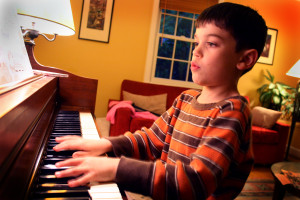Replay: a new teaching strategy?
I am very excited about research concerning the repeated hearing of musical phrases. Why do we listen to our favourite music over and over again? Because repeated sounds work magic in our brains. Even though the research pertains directly to listening to music, I think it has great potential for teaching and learning—so much so that I would like to lay claim to a strategy that I will call, “Replay.”

image from Wikipedia Commons
The post—by Arkansas musicologist Elizabeth Hellmuth Margulis—suggests that what makes music enjoyable is not our hearing of it, but our RE-hearing of it. In other words we reproduce the music from our memories as we listen to it playing. “When you hear something as music, you aren’t so much listening to as listening along with.” Our minds are actually anticipating and producing the music at the same instant that we hear it. “In fact, part of what it means to listen to something musically is to participate imaginatively.” There is pleasure in anticipating what notes and words come next, then hearing our predictions come true. And conversely, a displeasure when we might hear someone interrupt the playing of or reproduce a bad version of a favourite song.
This helps me understand why there are greatest hits that people enjoy replaying, sometimes ad nauseam, why fans go wild at concerts when favorite bands play their hits, no matter how old, and why I listen to Kind of Blue at least once a week. “The musicologist David Huron at Ohio State University estimates that, during more than 90 per cent of the time spent listening to music, people are actually hearing passages that they’ve listened to before.”
What I find so exciting about the replay concept is that I think it intersects in a powerful way with learning theory and classroom practice. If we get pleasure, affirmation and comfort from listening to music replayed, might that same strategy enhance our learning? Might re-producing a recently-learned concept or skill consolidate it?
I think there is evidence for this notion in many places. Young children enjoy reading the same books, listening to the same songs and seeing the same videos repeatedly. It isn’t the newness of the experiences that they enjoy but rather the familiarity and comfort of the replay and the reinforcement in the repetition. Each repetition adds to their understanding.
In media literacy education, we advocate for repeated viewings, listenings or explorations of media texts in order for students to become aware of their multi-modal messages. The first experience is just one of orientation and familiarity. Exploration, analysis and reflection—learning—can only occur in the second, third or fourth exposures. In other words, the learning occurs as a result of replay. It may very well be that the reason I find the replay notion exciting is that replay is itself a replay of a strategy I use often.
One of the challenges teachers face is a crowded curriculum that seems to allow for only a single exposure to new knowledge. How can we expect students to orient and learn in one pass, when learning occurs as a result of familiarity and reflection?
Could replay be the engine that drives the success of the flipped classroom? In the flipped classroom, students have the orientation and familiarity experience as homework. In the classroom, students are exposed to the ideas for at least the second, if not the third time. They are not coming to the material for the first time but are seeing it replayed with teacher guidance. As useful as the teacher guidance might be, the replay might be equally important because the orientation phase is complete, the familiarity achieved.
Could replay be the engine that drives the success of peer teaching and mentoring? Before students can be peer teachers or mentors, they must achieve significant mastery of the ideas they are teaching. That mastery comes from the repetition of skills and knowledge—replay.
Replay is also applicable to sports, music, drama and dance. Athletes, musicians, actors and dancers attain winning style when they repeat skills and strategies often enough during practices and rehearsals to be able to execute them unconsciously. Their first executions may be awkward, but coaching that raises their awareness of the activity’s codes and conventions and the familiarity of repetition ‘naturalizes’ their behaviours.
Replay also has significant implications for media production. If students are producing media texts to demonstrate their learning—no matter the subject—they must be familiar with the ideas—replay—before they can communicate them. Whether they are writing a script, editing a video or revising an infographic, they are replaying contents as well as media codes and conventions. As they replay the content, it is assimilated more effectively. As they execute the codes and conventions, they learn media concepts and language more effectively.
In each of these cases, replay is the strategy leading to effective learning.
The only research in this post is the musical application. The rest is my conjecture. I would be very pleased to see research that would test the effectiveness of replay as a learning strategy.
Replay might seem to be rote learning with a different name. The difference between them for me is that rote is memorization without necessarily understanding whereas replay is repeating experiences for the purposes of reflection and better understanding.


